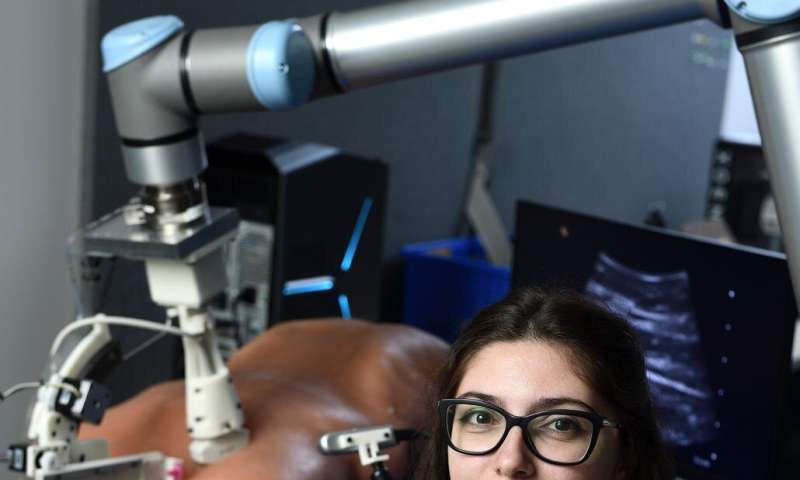Robot tackles trauma's silent killer

A Johns Hopkins University doctoral student is developing an AI-powered robot that could one day help first responders detect and treat life-threatening internal bleeding on the way to the hospital.
"A significant percentage of pre-hospital trauma deaths are classified as potentially survivable, with the primary cause being uncontrolled internal bleeding, called hemorrhages," said Lidia Al-Zogbi, a fifth-year doctoral student in the Department of Mechanical Engineering at the Whiting School of Engineering. "There is a concept known as the 'golden hour'—the critical 60-minute window after a traumatic injury occurs. If patients are not stabilized within that timeframe, their chances of survival decrease dramatically."
To help improve those odds, Al-Zogbi is working in Axel Krieger's IMERSE (Intelligent Medical Robotic Systems and Equipment) Lab to integrate robotics and artificial intelligence solutions for faster patient care. She has programmed a robot to initiate a FAST (Focused Assessment with Sonography in Trauma) Scan via ultrasound, which can alert doctors to hemorrhages while the patient is still en route. If a hemorrhage is detected, the robot can insert an intra-arterial balloon catheter, which can temporarily stem the bleeding until the patient reaches the medical center and a surgeon can take over. This innovative approach can be lifesaving, as it gives clinicians valuable extra time to analyze and assess ultrasound images so they are ready to treat the patient effectively once they arrive.
"Lidia's work in developing this system is truly impressive and could be a game-changer," says Krieger, an assistant professor of mechanical engineering. "The combination of robotics, AI, and imaging could buy injured people precious time post-trauma when it could really make a difference."
Ultrasound imaging is a critical factor in helping emergency personnel identify hemorrhages early, Al-Zogbi said. Though typically tethered to a hospital or office workstation, the technology can be mobilized, wirelessly connecting to an iPad or other tablet. Even so, few EMTs and other first responders have the training or equipment to use ultrasound technology in the field or aboard an ambulance. As a result, by the time the patient arrives at the hospital and imaging can take place, it may be too late.
"Getting these images to the doctors early buys them extra minutes, which can make all the difference to patients," Al-Zogbi said. "Our approach bridges the gap. This will help ensure that patients make it to the hospital, where doctors alerted to their condition are waiting."
Provided by Johns Hopkins University